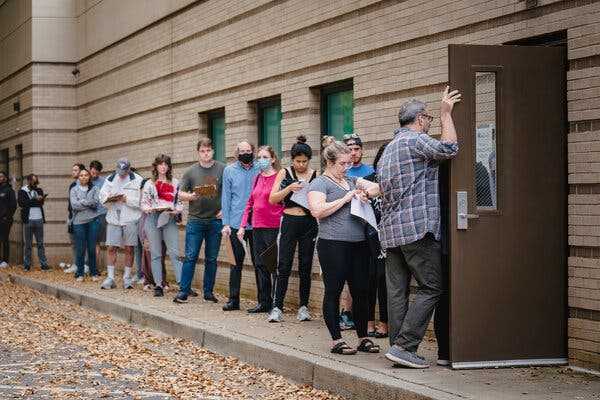Most states allow pre-election voting, which surged in popularity during the 2020 election, although rules vary.
-
Send any friend a story
As a subscriber, you have “>10 gift articles to give each month. Anyone can read what you share.
Give this articleGive this articleGive this article

Early voters lined up at the Joan P. Garner Library in Atlanta on Wednesday.
Election Day isn’t until next week, but the voting has already begun in much of the country.
Most states allow early voting, also known as pre-election voting, which surged in popularity during the 2020 election in response to the coronavirus pandemic. And interest remains high: As of Wednesday afternoon, nearly 30 million early ballots had been cast nationwide, according to data from the United States Elections Project.
In Georgia, in-person turnout was up 70 percent in the first five days of early voting compared with the 2018 midterm elections, according to the secretary of state’s office.
The rules vary by state, but there are a few different ways to vote early: Head to a polling place to fill out a ballot in person; drop off a completed ballot at a secure drop box, usually by a polling site or government building; or vote by mail before Election Day.
ImageDrop off a completed ballot at a drop box in Mesa, Ariz. on Friday.Credit…Rebecca Noble for The New York Times
Check your secretary of state’s website for details on your state’s early voting policies.
Alabama, Connecticut, Mississippi, and New Hampshire do not offer pre-election voting, according to the National Conference of State Legislatures.
As widespread as early voting is, it has recently come under attack by critics who complain about the potential for voter fraud, which is exceedingly rare.
On Tuesday, a federal judge in Arizona cracked down on an election-monitoring group staking out ballot boxes in Maricopa County. Members of the group, who cast themselves as “mule watchers” preventing fraud, were issued a temporary restraining order after complaints that they were intimidating and harassing voters. The individuals, some of whom were armed, had gathered around outdoor ballot boxes to take pictures of voters and, in some cases, posted the images online.
The A.C.L.U. said on Tuesday that it was investigating at least three separate reports of people monitoring ballot drop boxes in Chester County, Pa., which includes the Main Line suburbs west of Philadelphia. None appeared armed, the group said.
Source: nytimes.com



